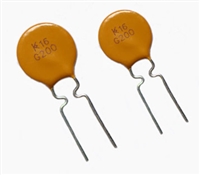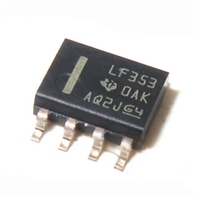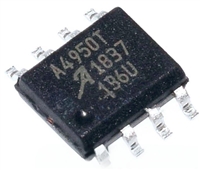PRELIMINARY TECHNICAL DATA
AD5280/AD5282
For example, RAB=20KΩ, when VA = 0V and B–terminal is open
2 bits are determined by the state of the AD0 and AD1 pins of
the device. AD0 and AD1 allow the user to use up to four of
these devices on one bus.
circuit, the following output resistance RWA will be set for the
following RDAC latch codes. Result will be the same if terminal
B is tied to W:
The 2-wire I2C serial bus protocol operates as follows:
1. The master initiates data transfer by establishing a START
condition, which is when a high-to-low transition on the
SDA line occurs while SCL is high, Figure 2. The
following byte is the Slave Address Byte which consists of
the 7-bit slave address followed by an R/W bit (this bit
determines whether data will be read from or written to the
slave device).
D
RWA
Output State
(DEC) (Ω)
256
128
1
60
Full-Scale
10060 Mid-Scale
19982 1 LSB
20060 Zero-Scale
0
The slave whose address corresponds to the transmitted
address responds by pulling the SDA line low during the
ninth clock pulse (this is termed the Acknowledge bit). At
this stage, all other devices on the bus remain idle while the
selected device waits for data to be written to or read from
its serial register. If the R/W bit is high, the master will read
from the slave device. On the other hand, if the R/W bit is
low, the master will write to the slave device.
The typical distribution of the nominal resistance RAB from
channel-to-channel matches within ±1%. Device to device
matching is process lot dependent and is possible to have ±30%
variation. Since the resistance element is processed in thin film
technology, the change in RAB with temperature has a 30
ppm/°C temperature coefficient.
2. A Write operation contains an extra Instruction Byte more
than the Read operation. Such Instruction Byte in Write
mode follows the Slave Address Byte. The MSB of the
Instruction Byte labeled A/B is the RDAC sub-address
select. A “low” select RDAC1 and a “high” selects RDAC2
for dual channel AD5282. The 2nd MSB RS is the Mid-
scale reset. A logic high of this bit moves the wiper of a
selected RDAC to the center tap where RWA=RWB. The 3rd
MSB SD is a shutdown bit. A logic high causes the RDAC
open circuit at terminal A while shorting wiper to terminal
B. This operation yields almost a zero Ohm in rheostat
mode or zero volt in potentiometer mode. This SD bit
serves the same function as the SHDN pin except it reacts in
active low. The following two bits are O2 and O1. They are
extra programmable logic output that users can make use of
them by driving other digital loads, logic gates, LED
drivers, and analog switches, etc. The 3 LSBs are DON’T
CARE. See Figure 2.
PROGRAMMING THE POTENTIOMETER DIVIDER
Voltage Output Operation
The digital potentiometer easily generates output voltages at
wiper-to-B and wiper-to-A to be proportional to the input
voltage at A-to-B. Let’s ignore the effect of the wiper resistance
at the moment. For example connecting A–terminal to +5V and
B–terminal to ground produces an output voltage at the wiper-
to-B starting at zero volts up to 1 LSB less than +5V. Each LSB
of voltage is equal to the voltage applied across terminal AB
divided by the 256 position of the potentiometer divider. Since
AD5280/AD5282 can be supplied by dual supplies, the general
equation defining the output voltage at VW with respect to
ground for any given input voltage applied to terminals AB is:
D
256 − D
VW (D) =
VA
+
VB
eqn.3
256
256
3. After acknowledged the Instruction Byte, the last byte in
Write mode is the Data Byte. Data is transmitted over the
serial bus in sequences of nine clock pulses (eight data bits
followed by an “Acknowledge” bit). The transitions on the
SDA line must occur during the low period of SCL and
remain stable during the high period of SCL, Figure 1.
where D is decimal equivalent of the binary code which is
loaded in the 8-bit RDAC register.
Operation of the digital potentiometer in the divider mode
results in a more accurate operation over temperature. Unlike
the rheostat mode, the output voltage is dependent on the ratio
of the internal resistors RWA and RWB and not the absolute values,
therefore, the temperature drift reduces to 5ppm/°C.
4. In Read mode, the Data Byte goes right after the
acknowledgment of the Slave Address Byte. Data is
transmitted over the serial bus in sequences of nine clock
pulses (slight difference with the Write mode, there are
eight data bits followed by a “No Acknowledge” bit).
Similarly, the transitions on the SDA line must occur
during the low period of SCL and remain stable during the
high period of SCL.
DIGITAL INTERFACE
2-WIRE SERIAL BUS
The AD5280/AD5282 are controlled via an I2C compatible
serial bus. The RDACs are connected to this bus as slave
devices.
5. When all data bits have been read or written, a STOP
condition is established by the master. A STOP condition is
defined as a low-to-high transition on the SDA line while
SCL is high. In Write mode, the master will pull the SDA
line high during the 10th clock pulse to establish a STOP
Referring from Figures 2 and 3, the first byte of
AD5280/AD5282 is a Slave Address Byte. It has a 7-bit slave
address and a R/W bit. The 5 MSBs are 01011 and the following
REV PrE 12 MAR 02
7
Information contained in this Product Concept Data Sheet describes a product in the early definition stage. There is no guarantee that the information contained here will become a final
product in its present form. For latest information contact Walt Heinzer/Analog Devices, Santa Clara, CA. TEL 408 382-3107; FAX 408 382-2721; email; walt.heinzer@analog.com






 NTC热敏电阻与PTC热敏电阻的应用原理及应用范围
NTC热敏电阻与PTC热敏电阻的应用原理及应用范围

 GTO与普通晶闸管相比为什么可以自关断?为什么普通晶闸管不能呢?从GTO原理、应用范围带你了解原因及推荐型号
GTO与普通晶闸管相比为什么可以自关断?为什么普通晶闸管不能呢?从GTO原理、应用范围带你了解原因及推荐型号

 LF353数据手册解读:特性、应用、封装、引脚说明、电气参数及替换型号推荐
LF353数据手册解读:特性、应用、封装、引脚说明、电气参数及替换型号推荐

 A4950资料手册解读:特性、应用、封装、引脚功能、电气参数及代换型号
A4950资料手册解读:特性、应用、封装、引脚功能、电气参数及代换型号
